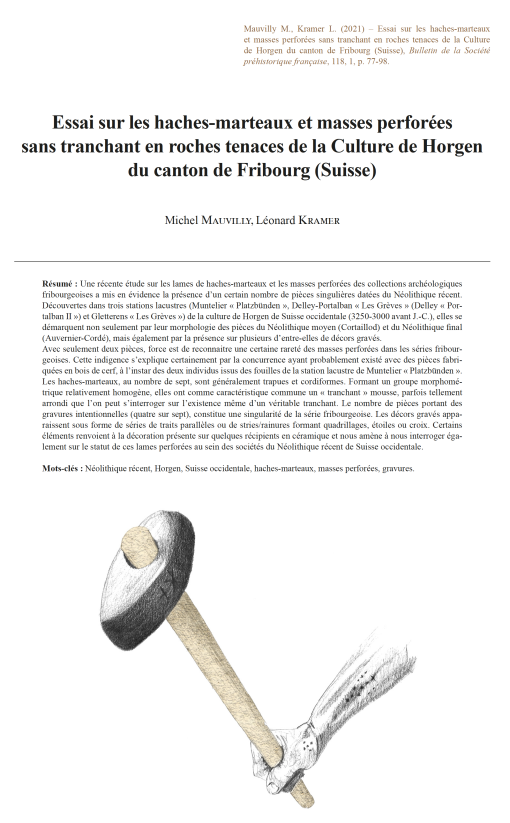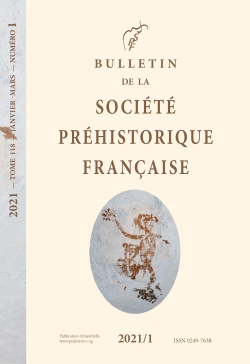Prix : 15,00 €TTC
03-2021, tome 118, 1, p.77-98 - M. MAUVILLY, L. KRAMER - Essai sur les haches-marteaux et masses perforées sans tranchant en roches tenaces de la Culture de Horgen du canton de Fribourg (Suisse)
Essai sur les haches-marteaux et masses perforées sans tranchant en roches tenaces de la Culture de Horgen du canton de Fribourg (Suisse) p. 77-98
Michel Mauvilly & Léonard Kramer
Résumé : Une récente étude sur les lames de haches-marteaux et les masses perforées des collections archéologiques fribourgeoises a mis en évidence la présence d'un certain nombre de pièces singulières datées du Néolithique récent. Découvertes dans trois stations lacustres (Muntelier « Platzbünden », Delley-Portalban « Les Grèves » (Delley « Portalban II ») et Gletterens « Les Grèves ») de la culture de Horgen de Suisse occidentale (3250-3000 avant J.-C.), elles se démarquent non seulement par leur morphologie des pièces du Néolithique moyen (Cortaillod) et du Néolithique final (Auvernier-Cordé), mais également par la présence sur plusieurs d'entre-elles de décors gravés. Avec seulement deux pièces, force est de reconnaitre une certaine rareté des masses perforées dans les séries fribourgeoises. Cette indigence s'explique certainement par la concurrence ayant probablement existé avec des pièces fabriquées en bois de cerf, à l'instar des deux individus issus des fouilles de la station lacustre de Muntelier « Platzbünden ». Les haches-marteaux, au nombre de sept, sont généralement trapues et cordiformes. Formant un groupe morphométrique relativement homogène, elles ont comme caractéristique commune un « tranchant » mousse, parfois tellement arrondi que l'on peut s'interroger sur l'existence même d'un véritable tranchant. Le nombre de pièces portant des gravures intentionnelles (quatre sur sept), constitue une singularité de la série fribourgeoise. Les décors gravés apparaissent sous forme de séries de traits parallèles ou de stries/rainures formant quadrillages, étoiles ou croix. Certains éléments renvoient à la décoration présente sur quelques récipients en céramique et nous amène à nous interroger également sur le statut de ces lames perforées au sein des sociétés du Néolithique récent de Suisse occidentale.
Mots-clés : Néolithique récent, Horgen, Suisse occidentale, haches-marteaux, masses perforées, gravures.
Abstract: A recent study of stone battle-axes and mace-heads in the canton of Fribourg archaeological collections has brought to light a number of singular pieces dated to the Late Neolithic period. They come from the three main pile dwellings sites of the Horgen culture in western Switzerland (3250 - 3000 BC) : - Muntelier « Platzbünden » : This site is located on the shores of Lake Murten. A partial excavation of the village took place between 1978 and 1982. The thickness of the archaeological layer observed is in places more than 80 cm. Dendrochronological data indicates that it was occupied between 3229 and 3110 BC. - Gletterens « Les Grèves » : Located on the shores of Lake Neuchatel, this pile dwellings site has been known since the 19th century. Two archaeological layers related to the culture of Cortaillod and Horgen were discovered during excavations prior to the construction of a building between 1980 and 1987. Concerning the period of the Horgen culture, this site was occupied between 3286 and 3149 BC. It is currently a UNESCO World Heritage Site. - Delley « Portalban II » : The excavation of this lakeside village took place between 1962 and 1979 in one of the richest areas of pile dwellings sites in the canton of Fribourg. Occupations from the Middle Neolithic to the end of the Final Neolithic have been identified. Dendrochronology indicates that this village of the Culture of Horgen was occupied between 3272 and 3095 BC. On the scale of canton of Fribourg, the distribution of the Late Neolithic sites shows that they are mostly located in the low altitude zones near the lakes. Those located in the immediate hinterland of the lakes are certainly linked to hunting, agricultural and forest exploitation practices. A secondary spot of occupation has been observed along the Sarine canyon. These sites are certainly related to the exploitation of a riverside environment and along an axis of passage. Battle-axes and mace-heads from the Culture of Horgen are distinguished by their morphology of pieces from the Middle Neolithic (Cortaillod) and the Final Neolithic (Auvernier-Cordé), but also by the presence on several of them of engraved decorations. Only two mace-heads are known for the canton of Fribourg. They come from the Delley « Portalban II » site. This rarity is probably due to the existence of similar objects made of deer antlers. Two of them were found at Muntelier « Platzbünden ». In Switzerland, these objects are also quite rare in collections. The seven battle-axes from the Culture of Horgen are generally compact and cordiform. They form a relatively homogeneous morphometric group with a smooth or very rounded edge. The length of these pieces is between 97 and 119 mm for a width of 43 to 64 mm. The diameter of the perforation is also quite regular (between 15 and 22 mm). Five of these objects were discovered at Muntelier « Platzbünden », one at Delley « Portalban II » and one at Gletterens « Les Grèves ». Four pieces bear intentional engravings, which is a particularity of the canton of Fribourg. In Swiss literature, only three sites (Zürich « Parkhaus », Zürich « Opera » and Hünenberg « Chämleten ») have delivered comparable specimens. There are also rare antler battle-axes. Two pieces have been identified in two Horgen sites in Three-Lakes Region (Muntelier « Platzbünden » and Saint-Blaise « Bains des Dames ». In contrast to rock battle-axes, which are rare, and as numerous finds in the various pile dwellings sites of the Culture of Horgen show, deer antler battle-axes are part of the common tools made from hard materials of animal origin. On the battle-axes, the engraved decorations appear as a series of parallel lines or striations / grooves forming squares, stars or crosses. They are mainly located on the flanks or sometimes on the upper part and were made after polishing. Similar elements can be also found on contemporary axes. On the engraved Horgen pieces, the signs often appear to be organized in series, each one corresponding either to a type of sign or to signs opposing or complementing each other. These signs also seem to combine with each other, notably through symmetry effects. While these engraved signs may correspond to distinctive property marks, a basic system of accounting or embellishment, they may just as well have been invested with apotropaic, prophylactic, or perhaps a simplified form of symbolic cosmology. Some of these signs are also found on ceramics of the Culture of Horgen. They are not part of the ordinary vase decorations. As rare as the signs on the battle-axes are, these engraved motifs are usually simple, vertical, horizontal, or oblique segments that cross each other. There are also more complex elements forming sun, rake, fir, or herringbone decorations. All of these patterns are also found on axes. These battle-axes, because of the time of manufacture, were given a special status like almost all perforated rock objects of the Neolithic period. Some authors attribute a purely symbolic value to these particular objects refuting a more functional use. Because of their relative fragility, these pieces are not for example the best tools for splitting wood. On the other hand, it is possible that in combination with a wooden handle, they could have been used as a weapon.
Keywords: Late Neolithic, Horgen, Western Switzerland, battle-axes, mace-heads, engravings.




